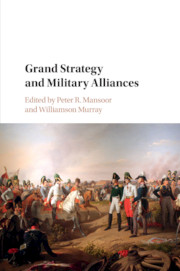Refine search
Actions for selected content:
15418 results in Military history
1 - Introduction: Grand strategy and alliances
-
-
- Book:
- Grand Strategy and Military Alliances
- Published online:
- 05 February 2016
- Print publication:
- 09 February 2016, pp 1-16
-
- Chapter
- Export citation

Grand Strategy and Military Alliances
-
- Published online:
- 05 February 2016
- Print publication:
- 09 February 2016
4 - Capturing the battlefield: Mapping and air photography at Gallipoli
-
-
- Book:
- Anzac Battlefield
- Published online:
- 05 December 2015
- Print publication:
- 05 January 2016, pp 59-82
-
- Chapter
- Export citation
7 - Forming the Ottoman battlefield
-
-
- Book:
- Anzac Battlefield
- Published online:
- 05 December 2015
- Print publication:
- 05 January 2016, pp 138-158
-
- Chapter
- Export citation
8 - Artefacts from the battlefield
-
-
- Book:
- Anzac Battlefield
- Published online:
- 05 December 2015
- Print publication:
- 05 January 2016, pp 159-191
-
- Chapter
- Export citation
Contributors
-
- Book:
- Anzac Battlefield
- Published online:
- 05 December 2015
- Print publication:
- 05 January 2016, pp xvii-xviii
-
- Chapter
- Export citation
5 - Battlefield archaeology: Gallipoli
-
-
- Book:
- Anzac Battlefield
- Published online:
- 05 December 2015
- Print publication:
- 05 January 2016, pp 83-97
-
- Chapter
- Export citation
Conclusion
-
-
- Book:
- Anzac Battlefield
- Published online:
- 05 December 2015
- Print publication:
- 05 January 2016, pp 244-245
-
- Chapter
- Export citation
Index
-
- Book:
- Anzac Battlefield
- Published online:
- 05 December 2015
- Print publication:
- 05 January 2016, pp 261-268
-
- Chapter
- Export citation
Acknowledgements
-
- Book:
- Anzac Battlefield
- Published online:
- 05 December 2015
- Print publication:
- 05 January 2016, pp xix-xx
-
- Chapter
- Export citation
2 - The Gallipoli campaign: History and legend
-
-
- Book:
- Anzac Battlefield
- Published online:
- 05 December 2015
- Print publication:
- 05 January 2016, pp 24-35
-
- Chapter
- Export citation
Gallipoli battlefield place names
-
- Book:
- Anzac Battlefield
- Published online:
- 05 December 2015
- Print publication:
- 05 January 2016, pp xxiii-xxvi
-
- Chapter
- Export citation
References
-
- Book:
- Anzac Battlefield
- Published online:
- 05 December 2015
- Print publication:
- 05 January 2016, pp 251-260
-
- Chapter
- Export citation
10 - Remembering Gallipoli from a Turkish perspective
-
-
- Book:
- Anzac Battlefield
- Published online:
- 05 December 2015
- Print publication:
- 05 January 2016, pp 222-243
-
- Chapter
- Export citation
Appendix - Anzac Gallipoli Archaeological Database
-
-
- Book:
- Anzac Battlefield
- Published online:
- 05 December 2015
- Print publication:
- 05 January 2016, pp 246-250
-
- Chapter
- Export citation
Introduction
-
-
- Book:
- Anzac Battlefield
- Published online:
- 05 December 2015
- Print publication:
- 05 January 2016, pp 1-3
-
- Chapter
- Export citation
Plates
-
- Book:
- Anzac Battlefield
- Published online:
- 05 December 2015
- Print publication:
- 05 January 2016, pp xiii-xvi
-
- Chapter
- Export citation
Contents
-
- Book:
- Anzac Battlefield
- Published online:
- 05 December 2015
- Print publication:
- 05 January 2016, pp ix-x
-
- Chapter
- Export citation
Figures
-
- Book:
- Anzac Battlefield
- Published online:
- 05 December 2015
- Print publication:
- 05 January 2016, pp xi-xii
-
- Chapter
- Export citation
6 - Forming the ANZAC battlefield
-
-
- Book:
- Anzac Battlefield
- Published online:
- 05 December 2015
- Print publication:
- 05 January 2016, pp 98-137
-
- Chapter
- Export citation
